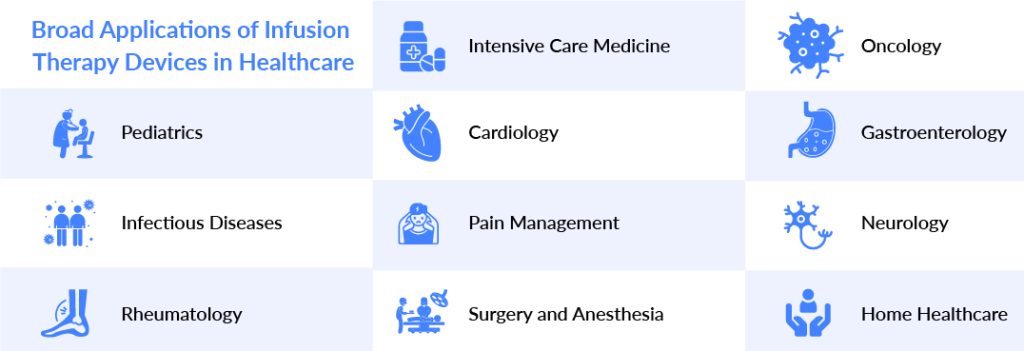Infusion Therapy Devices: Revolutionizing Healthcare Delivery
Jun 12, 2024
Table of Contents
In contemporary healthcare, technological progress has profoundly reshaped how patients are treated. One such innovation that has revolutionized healthcare delivery is the development of infusion therapy devices. These devices have become indispensable tools in administering fluids, medications, and nutrients directly into a patient’s bloodstream, offering precise dosage control and improving treatment outcomes across various medical specialties.
Understanding Infusion Therapy Devices
Infusion therapy devices encompass a wide range of equipment designed to deliver fluids or medications intravenously, subcutaneously, or epidurally. These devices include infusion pumps, catheters, IV sets, and accessories, each serving a specific purpose in the administration process.
Downloads
Click Here To Get the Article in PDF
Recent Articles
- Which Companies are Vying to get a Major Chunk in the Elastomeric Pump Market?
- A promising immune-stimulating target
- GE HealthCare Launched CardioVisio; J&J’s Elita Laser Correction Platform; ICU Medical’s Plum...
- Oncolytic Viruses: Can Be The Next Frontier in Cancer Immunotherapy?
- AKT Inhibitors: A potential Cancer Immunotherapy Target
Infusion pumps, the cornerstone of infusion therapy, come in various forms, such as syringe pumps, volumetric pumps, and ambulatory pumps. These devices ensure accurate and controlled delivery of fluids and medications at programmed rates, minimizing the risk of under- or overdosing.
As per DelveInsight analysis, the global infusion pumps market was valued at USD 13.80 billion in 2023, growing at a CAGR of 9.54% during the forecast period from 2024 to 2030, to reach USD 23.85 billion by 2030. The demand for infusion pumps is primarily motivated by the increasing prevalence of chronic diseases, the increase in the demand for remote patient monitoring, growing research and development activities to launch home infusion systems, and the increasing cost of hospital-based infusion therapies.
Catheters play a vital role in accessing the patient’s bloodstream or subcutaneous tissue for infusion purposes. Peripheral catheters are commonly used for short-term infusions, while central venous catheters provide access to larger veins and are suitable for long-term therapy or administering irritant medications.
IV sets, comprising tubing, connectors, and filters, facilitate the seamless connection between the infusion pump and the patient’s vascular access device. These sets are designed to maintain sterility and prevent air embolisms during infusion.
Advantages of Infusion Therapy Devices
Infusion therapy devices have revolutionized patient care by offering a myriad of advantages across various medical settings. Firstly, these devices provide precise and controlled delivery of medications, ensuring accurate dosing tailored to individual patient needs. This precision minimizes the risk of medication errors, enhancing patient safety and therapeutic outcomes.

Moreover, infusion therapy devices offer convenience and flexibility, allowing for continuous or intermittent delivery of medications without the need for frequent injections or hospital visits. This versatility not only improves patient comfort but also promotes adherence to treatment regimens, particularly for chronic conditions requiring long-term therapy. Additionally, these devices enable healthcare providers to monitor and adjust medication delivery in real time, optimizing therapeutic efficacy while minimizing potential side effects. Overall, infusion therapy devices represent a cornerstone of modern healthcare, offering efficient, safe, and patient-centered solutions for a wide range of medical conditions.
Applications of Infusion Therapy Devices Across Medical Specialties
Infusion therapy devices are indispensable tools across various medical specialties, revolutionizing patient care and treatment modalities. In oncology, these devices play a pivotal role in delivering chemotherapy, immunotherapy, and supportive care medications. The precise control afforded by infusion pumps ensures optimal drug delivery, minimizing toxicity while maximizing therapeutic efficacy. In critical care, infusion therapy devices are lifelines, delivering vital fluids, medications, and nutrition to patients in intensive care units. These devices are essential for maintaining hemodynamic stability, managing pain, and combating infections in critically ill patients.
In anesthesia, infusion therapy devices provide accurate administration of anesthesia agents and adjunctive medications during surgical procedures. These devices enable anesthesiologists to tailor drug dosages to individual patient needs, ensuring precise control over sedation levels and pain management. Moreover, infusion pumps are indispensable in obstetrics and gynecology for administering uterotonic agents during labor induction and controlling postpartum hemorrhage, safeguarding maternal and fetal health.

Across specialties such as cardiology, gastroenterology, and rheumatology, infusion therapy devices are instrumental in delivering biologic therapies, antibiotics, and vasoactive medications. Whether in hospital settings, outpatient clinics, or home care environments, infusion therapy devices enhance patient comfort, safety, and treatment outcomes across diverse medical disciplines. As technology continues to advance, these devices will undoubtedly play an increasingly integral role in modern healthcare, driving innovation and improving patient care standards worldwide.
Infusion Therapy Devices Market Dynamics
The infusion therapy devices market is dynamically evolving, driven by a confluence of factors ranging from technological advancements to the increasing prevalence of chronic diseases. As per DelveInsight analysis, the global infusion therapy devices market is estimated to grow at a CAGR of 6.56% during the forecast period from 2024 to 2030 to reach USD 77.65 billion by 2030.
With a rising aging population worldwide, the demand for infusion therapy devices is expected to surge, as these devices are integral in administering medication and fluids directly into the patient’s bloodstream. Moreover, the escalating incidence of conditions such as cancer, diabetes, and autoimmune disorders further propels market growth, necessitating the continuous development of advanced infusion therapy solutions to meet diverse healthcare needs.
Additionally, the shift towards home-based healthcare settings and ambulatory care centers is reshaping the landscape of infusion therapy, fostering the demand for portable and user-friendly infusion devices. Patients prefer the convenience and comfort of receiving treatments at home, thereby driving the adoption of infusion pumps and accessories that facilitate self-administration and remote monitoring. Furthermore, stringent regulations and guidelines governing the safety and efficacy of infusion therapy devices compel manufacturers to invest in research and development activities, fostering innovation and product enhancement.
However, despite the promising growth prospects, the infusion therapy devices market faces challenges such as the high cost associated with advanced devices, reimbursement complexities, and the risk of infections associated with prolonged device usage. Moreover, the emergence of alternative drug delivery methods such as oral medications and inhalation therapies poses a competitive threat to the market. To sustain growth amidst these challenges, industry players are focusing on strategic collaborations, mergers, and acquisitions to expand their product portfolios and geographic presence, thereby capitalizing on emerging opportunities in the global healthcare landscape.
Key Players Active in the Infusion Therapy Devices Market
The infusion therapy devices market is a dynamic landscape shaped by various key players including Fresenius Kabi AG, Ossila, Ace-medical, ICU Medical, Chmyx Inc., Mindray, Baxter, Becton, Dickinson and Company, Micrel Medical Devices SA, AKAS Infusions, Narang Medical Limited, Monidor Oy., Smiths Group plc., B. Braun SE, Trivitron Healthcare, Eitan Medical, and others driving innovation and efficiency in healthcare delivery. Among the prominent names in this arena, Becton Dickinson and Company (BD) stands out for its comprehensive portfolio of infusion pumps, catheters, and accessories, catering to diverse clinical needs. BD’s focus on patient safety and advanced technology has solidified its position as a leader in the infusion therapy sector.

Another notable player infusion therapy devices market is Baxter International Inc., renowned for its innovative infusion systems designed to enhance medication delivery accuracy and patient comfort. Baxter’s commitment to developing cutting-edge solutions for both acute and chronic care settings underscores its significant influence in the global infusion therapy devices market.
Smiths Medical, a subsidiary of Smiths Group plc, is also a key player, renowned for its infusion pumps and administration sets known for their precision, reliability, and user-friendly designs. Smiths Medical’s continuous investment in research and development ensures a steady stream of advanced infusion therapy solutions, contributing to its prominence in the market.
Moreover, ICU Medical Inc. has emerged as a key player with its focus on infusion therapy products that prioritize patient safety, clinician efficiency, and reduced healthcare costs. ICU Medical’s innovative needle-free connectors and infusion sets have gained widespread adoption, further solidifying its position in the competitive infusion therapy devices market. Collectively, these key players drive the evolution of infusion therapy, shaping the future of healthcare delivery worldwide.
Future of Infusion Therapy Devices
Infusion therapy devices are poised for a transformative journey in the coming years, driven by advancements in technology, evolving patient needs, and the healthcare landscape’s shifting demands. The future of infusion therapy devices promises a blend of innovation and efficiency, aiming to enhance patient outcomes while streamlining healthcare delivery.
One key aspect of the future of infusion therapy devices lies in their increasing integration with digital health platforms. These devices are expected to become more interconnected, allowing for seamless data transmission and remote monitoring. This connectivity enables healthcare providers to closely monitor patients’ infusion therapies in real time, facilitating timely interventions and adjustments as needed. Moreover, data analytics derived from these devices can offer valuable insights into patient responses and treatment efficacy, empowering clinicians to personalize therapies and optimize patient care pathways.
Furthermore, advancements in materials science and miniaturization techniques are anticipated to revolutionize the design and functionality of infusion therapy devices. Future devices may feature smaller, more lightweight designs, enhancing patient comfort and mobility. Additionally, the integration of novel materials and smart sensors could enable enhanced drug delivery precision and compatibility with a broader range of medications. These innovations hold the potential to expand the applications of infusion therapy beyond traditional hospital settings, enabling home-based and ambulatory care solutions.
In tandem with technological advancements, the future of infusion therapy devices will also be shaped by a growing emphasis on patient-centric care and user experience. Manufacturers are likely to prioritize intuitive interfaces, ergonomic designs, and patient-friendly features to enhance usability and compliance. Moreover, efforts to minimize the environmental footprint of these devices through sustainable materials and manufacturing practices may also gain prominence. Ultimately, the future of infusion therapy devices is characterized by a convergence of technological innovation, patient-centered design, and a commitment to optimizing healthcare delivery.

Downloads
Article in PDF
Recent Articles
- Bristol Meyers Squibb & AbbVie partner; BioLineRx’s collaboration with MD Anderson Cancer Ce...
- Collaboration provides new insight into cancer treatment
- CAR-T Cells vs. CAR-Exosome Agents: Exploring the Future of Cancer Immunotherapy
- PI3Kγ- a molecular switch that controls immune suppression
- Is Gene Therapy the Next Cancer Treatment Revolution?



